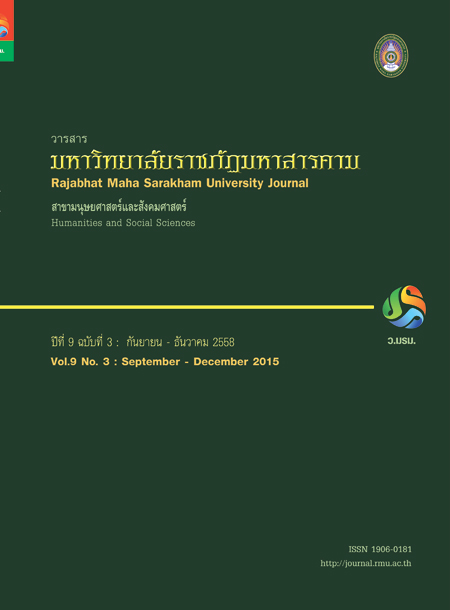รูปแบบการจัดการภาวะโภชนาการเกินของประชาชน จังหวัดบึงกาฬ A Model of Public Over-nutrition Management in Buengkan Province.
Main Article Content
บทคัดย่อ
การวิจัยครั้งนี้มีวัตถุประสงค์ ประการแรก เพื่อศึกษาปัจจัยเชิงสาเหตุที่มีผลต่อภาวะโภชนาการเกินของประชาชน จังหวัดบึงกาฬ
ประการที่สอง เพื่อสร้างรูปแบบการจัดการภาวะโภชนาการเกินของประชาชน จังหวัด บึงกาฬ และประการที่สาม เพื่อทดลองใช้และประเมิน
ผล รูปแบบการจัดการภาวะโภชนาการเกินของประชาชน จังหวัดบึงกาฬ วิธีดำเนินการวิจัยแบ่งเป็น 3 ระยะ คือ ระยะที่ 1 เป็นการวิจัยเชิง
ปริมาณ เพื่อศึกษาปัจจัยเชิงสาเหตุที่ส่งผลทางตรงและส่งผลทางอ้อม ต่อภาวะโภชนาการเกินของประชาชน จังหวัดบึงกาฬ โดยกำหนด
ปัจจัยเชิงสาเหตุ 8 ปัจจัย กลุ่มตัวอย่างคือ ประชาชนผู้มีภาวะโภชนาการเกินในจังหวัดบึงกาฬ จำนวน 395 คน ใช้วิธีการสุ่มตัวอย่างแบบ
การสุ่มตามระดับชั้น อย่างเป็นสัดส่วน Proportional stratified random sampling เก็บข้อมูลโดยใช้แบบสอบถาม วิเคราะห์ข้อมูลโดย
ใช้สถิติวิเคราะห์การถดถอยพหุคูณ (Multiple linear regression analysis) และใช้รูปแบบการวิเคราะห์สมการเชิงโครงสร้าง (Structural
equation model : SEM) โดยใช้โปรแกรมลิสเรล (LISREL for Windows) ระยะที่ 2 เป็นการสร้างรูปแบบการจัดการภาวะโภชนาการ
เกินของประชาชน จังหวัดบึงกาฬ ผู้วิจัยนำผลการวิจัยที่ได้จากการวิจัยระยะที่ 1 มาสร้างรูปแบบการจัดการภาวะโภชนาการเกินของประชาชน
จังหวัดบึงกาฬ โดยการจัดประชุมเชิงปฏิบัติการผู้เชี่ยวชาญ นักวิชาการ และผู้มีส่วนเกี่ยวข้องจำนวน 25 คน ใช้การประชุมกลุ่มย่อย (Focus
groups) แล้วส่งให้ผู้เชี่ยวชาญ 3 ท่าน ประเมินความเหมาะสมของรูปแบบอีกครั้งให้สมบูรณ์ยิ่งขึ้นก่อนนำไปทดลองใช้ ระยะที่ 3 เป็นการ
ทดลองใชแ้ ละประเมินผลรูปแบบการจัดการภาวะโภชนาการเกินของประชาชน จังหวัดบึงกาฬ กลมุ่ ทดลองคือ ประชาชนผทูี้่มีภาวะโภชนาการ
เกินในตำบลนาดง อำเภอปากคาด จังหวัดบึงกาฬ จำนวน 30 คน เปรียบเทียบผลการทดลองก่อนและหลังการใช้รูปแบบ และเปรียบเทียบ
กับกลุ่มควบคุม จำนวน 30 คน ทำการวิเคราะห์ข้อมูลด้วยการวิเคราะห์ความแปรปรวนร่วมหลายตัวแปรตาม (Multivariate analysis of
covariance : MANCOVA) โดยใช้ค่าวัดรอบเอว เป็นตัวแปรควบคุม (Covariate) ผลการวิจัยพบว่า
This research aimed to 1) analyze causal factors affecting over-nutrition of people in Beungkan
province, 2) design a model of management for over-nutrition of people in Beungkan province, and 3)
implement and evaluate the model of management for over nutrition of people in Beungkan province. The
research methodology was divided into 3 phases: 1) analyzing causal factors, 2) designing a model, and 3)
implementing and evaluating the model. Phase 1 was a quantitative study of causal factors directly and
indirectly affecting public over-nutrition in Beungkan Province; the target population consisted 395 Buengkan
residents, identified as having over-nutrition and obtained by using proportional stratified random sampling;
and the data were collected by using a questionnaire and treated by using LISREL for Windows to perform
Multiple Linear Regression Analysis, while Structural Equation Model : SEM was used to analyze causal
factors affecting the dependent variables against empirical data. Phase 2 was designing a model of public
over-nutrition in Beungkan Province which was based on Phase 1. The model was designed through a workshop
of 25 participants; the focus-group method was employed to discuss the public over-nutrition management
model; and the developed model was assessed by three experts. Phase 3 was implementing and evaluating
the model, using an experimental study of 30 participants, and comparison of the experimental and control
groups before and after implementation was analyzed using Multivariate Analysis of Covariance (MANCOVA).
Article Details
1. บทความที่ลงตีพิมพ์ทุกเรื่องได้รับการตรวจทางวิชาการโดยผู้ประเมินอิสระ ผู้ทรงคุณวุฒิ (Peer Review) สาขาที่เกี่ยวข้อง อย่างน้อย 3 ท่าน ในรูปแบบ Double blind review
2. ข้อคิดเห็นใด ๆ ของบทความที่ลงตีพิมพ์ในวารสารมหาวิทยาลัยราชภัฏมหาสารคาม นี้เป็นของผู้เขียน คณะผู้จัดทำวารสารไม่จำเป็นต้องเห็นด้วย
3. กองบรรณาธิการวารสารมหาวิทยาลัยราชภัฏมหาสารคาม ไม่สงวนสิทธิ์การคัดลอกแต่ให้อ้างอิงแสดงที่มา


